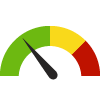Indicator Gauge Icon Legend
Legend Colors
Red is bad, green is good, blue is not statistically different/neutral.
Compared to Distribution
 the value is in the best half of communities.
the value is in the best half of communities.
 the value is in the 2nd worst quarter of communities.
the value is in the 2nd worst quarter of communities.
 the value is in the worst quarter of communities.
the value is in the worst quarter of communities.
Compared to Target
 meets target;
meets target;  does not meet target.
does not meet target.
Compared to a Single Value
 lower than the comparison value;
lower than the comparison value;
 higher than the comparison value;
higher than the comparison value;
 not statistically different from comparison value.
not statistically different from comparison value.
Trend

 non-significant change over time;
non-significant change over time; 
 significant change over time;
significant change over time;  no change over time.
no change over time.
Compared to Prior Value
 higher than the previous measurement period;
higher than the previous measurement period;
 lower than the previous measurement period;
lower than the previous measurement period;
 no statistically different change from previous measurement period.
no statistically different change from previous measurement period.
 Significantly better than the overall value
Significantly better than the overall value
 Significantly worse than the overall value
Significantly worse than the overall value
 No significant difference with the overall value
No significant difference with the overall value
 No data on significance available
No data on significance available
Adults with Arthritis
This indicator is archived and is no longer being updated. Click to learn more
Why is this important?
Arthritis is a collection of conditions and disorders of the joints, bones, muscles, cartilage and other connective tissues. According to the Arthritis Foundation, more than 50 million adults have doctor-diagnosed arthritis, and arthritis is the number 1 cause of disability in the U.S. Two common types of arthritis are Osteoarthritis (OA)and Rheumatoid arthritis (RA).
Osteoarthritis (OA), sometimes called degenerative joint disease, is the most common form of arthritis. Osteoarthritis is characterized by the breakdown of the joint's cartilage as well as bony overgrowth, leading to pain and joint stiffness. Common risk factors for OA include genetics, advanced age, obesity, and injury.
Rheumatoid arthritis (RA) is a systemic inflammatory arthritis and an autoimmune disease that typically affects the small joints of the hands and feet, but can also impact other organs. Symptoms include pain, swelling, stiffness and loss of function of the affected joint. Treatments include medications, lifestyle changes and surgery.
County: Morris
Measurement period: 2021
Maintained by: Conduent Healthy Communities Institute
Last update: April 2024
Graph Selections
| County | Source | Measurement Period | Percent | |
|---|---|---|---|---|
Data Sources
- State of New Jersey Department of Health
Maintained By: Conduent Healthy Communities Institute (Methodology)
Data source for Counties - CDC - PLACES
Note: This source uses Zip Code Tabulation Areas (ZCTAs) for its Zip Code data. Learn more
Maintained By: Conduent Healthy Communities Institute (Methodology)
Data source for Census Places (Cities), Zip Codes, Census Tracts
Note: Data for this indicator was obtained from multiple sources. Please interpret with caution as methodology may differ.
Filed under: Health / Other Conditions, Health Outcomes, Adults



